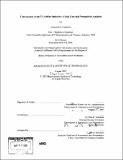| dc.contributor.advisor | Peter P. Belobaba. | en_US |
| dc.contributor.author | Tsoukalas, Gerassimos | en_US |
| dc.contributor.other | Massachusetts Institute of Technology. Dept. of Aeronautics and Astronautics. | en_US |
| dc.date.accessioned | 2008-09-03T14:52:01Z | |
| dc.date.available | 2008-09-03T14:52:01Z | |
| dc.date.copyright | 2007 | en_US |
| dc.date.issued | 2007 | en_US |
| dc.identifier.uri | http://hdl.handle.net/1721.1/42197 | |
| dc.description | Thesis (S.M.)--Massachusetts Institute of Technology, Dept. of Aeronautics and Astronautics, 2007. | en_US |
| dc.description | Includes bibliographical references (p. 201). | en_US |
| dc.description.abstract | The last decade has been a period of fundamental transformations for the US airline industry and has caused many carriers to make significant changes in their operational strategies. The traditional US network or "Legacy" carriers have had to deal with many new challenges including the devastating effects of 9/11, increased competition from low-cost airlines and increased volatility in fuel prices, to name a few. These setbacks have pushed many carriers into a financial crisis. In fact, four out of the six major airlines in the United States filed for bankruptcy protection between 2001 and 2005. In the midst of this crisis, these traditional carriers have had to concentrate on reducing their unit costs and improving their productivity levels in order to survive. The goal of the thesis is to examine to what extent these changes have led to a convergence in terms of unit costs and productivity levels between the Legacy carriers and their low-cost counterparts. Specifically we analyze and break down unit costs and productivity measures into their underlying components in order to identify what is driving change in the industry. We compare the different results at various levels of detail, including aggregate industry group trends, individual airline results and fleet-level based results comparing wide-body to narrow-body aircraft. We find that there are both qualitative and quantitative signs of convergence in several different categories in which LCCs have traditionally held a competitive advantage. These include unit costs excluding fuel and transport-related expenses, labor unit costs and employee wage productivity. On the Legacy side, the key forces driving improved efficiency have been dramatic labors cuts and higher stage lengths. | en_US |
| dc.description.abstract | (cont.) The former has been achieved by utilizing the bankruptcy while the latter results from the shifting of capacity towards international markets. On the LCC side we find that a significant increase in labor wages resulting from increased staff seniority has been the main source of losses in certain productivity results. Despite these signs of convergence, our fleet-level based analysis also showed that LCCs still retain a significant competitive advantage when isolating narrow-body fleets which are usually flown in the domestic US markets. | en_US |
| dc.description.statementofresponsibility | by Gerassimos Tsoukalas. | en_US |
| dc.format.extent | 201 p. | en_US |
| dc.language.iso | eng | en_US |
| dc.publisher | Massachusetts Institute of Technology | en_US |
| dc.rights | M.I.T. theses are protected by
copyright. They may be viewed from this source for any purpose, but
reproduction or distribution in any format is prohibited without written
permission. See provided URL for inquiries about permission. | en_US |
| dc.rights.uri | http://dspace.mit.edu/handle/1721.1/7582 | en_US |
| dc.subject | Aeronautics and Astronautics. | en_US |
| dc.title | Convergence in the US airline industry : a unit cost and productivity analysis | en_US |
| dc.title.alternative | Convergence in the United States airline industry : a unit cost and productivity analysis | en_US |
| dc.type | Thesis | en_US |
| dc.description.degree | S.M. | en_US |
| dc.contributor.department | Massachusetts Institute of Technology. Department of Aeronautics and Astronautics | |
| dc.identifier.oclc | 230816318 | en_US |
